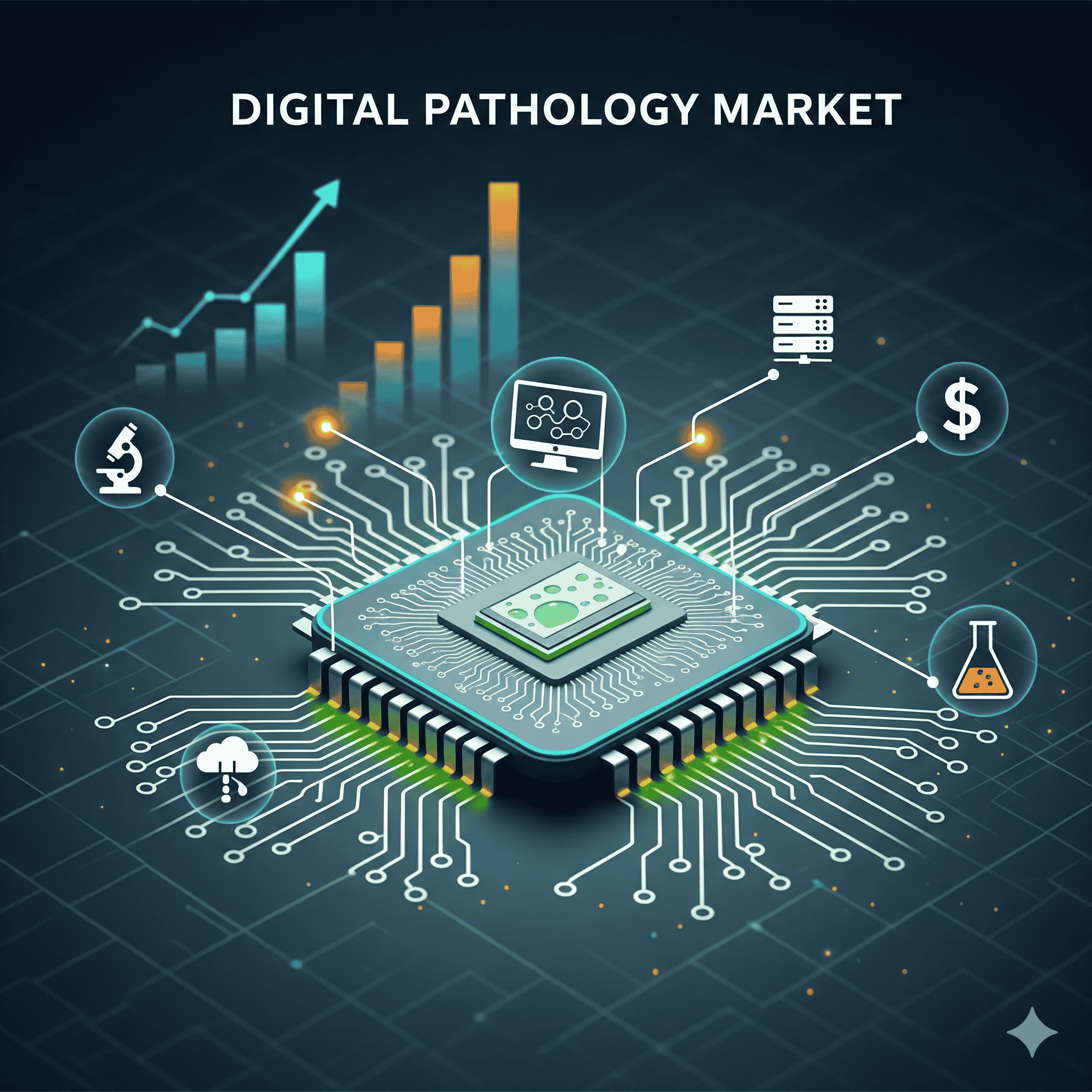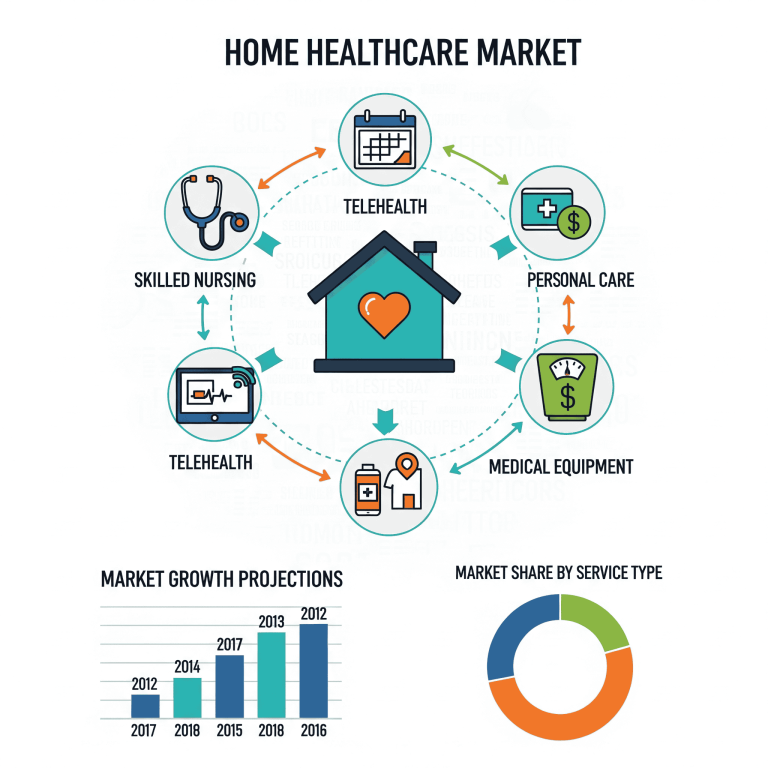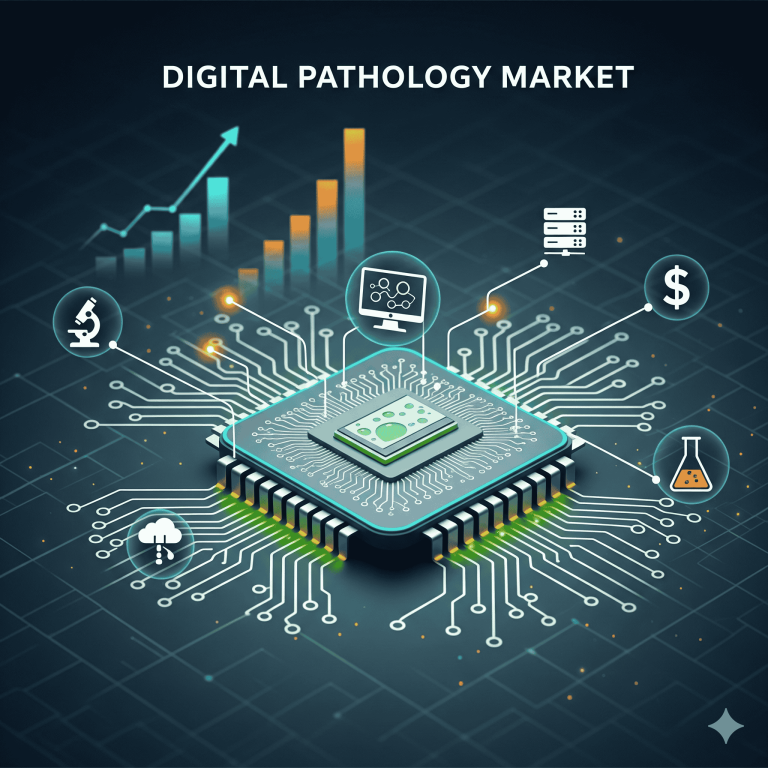
The global digital pathology market was valued at USD 1.14 billion in 2024, grew to USD 1.23 billion in 2025, and is projected to reach USD 2.51 billion by 2034, expanding at a CAGR of 8.24% (2025–2034), with North America holding 41% share in 2024 and Asia Pacific set for fastest growth.
Download the free sample and get the complete insights and forecasts report on this market @ https://www.towardshealthcare.com/download-sample/5647
Market Size
◈2024 → USD 1.14 billion
◈2025 → USD 1.23 billion
◈2034 → USD 2.51 billion
◈CAGR (2025–2034) → 8.24%
Leading Region (2024) → North America, 41% share
◈Strongest Growth Region (Forecast) → Asia Pacific
Key Dominating Segments (2024):
◈By Product → Devices (scanners, slide systems)
◈By Type → Human pathology
◈By Application → Academic research
◈By End Use → Hospitals
Market Trends in Digital Pathology
1. AI & ML Adoption
◈Precision Gains: AI models are improving diagnostic accuracy in tumor grading, metastasis detection, and rare disease identification, with error reduction rates of 15–25% compared to manual review (varies by cancer type).
◈Workflow Automation: AI-enabled scanners and slide management systems cut manual review times by up to 40%, boosting throughput in high-volume diagnostic labs.
◈Telepathology Enablement: AI triage systems pre-screen slides, flagging abnormal cases for pathologists in remote or resource-limited regions, helping bridge the global shortage of specialists.
2. Collaborations & Alliances
◈NVIDIA (Jan 2025): Partnering with healthcare leaders to embed agentic & generative AI in pathology imaging workflows → expected to enhance diagnostic precision and decision support in multi-center hospitals.
◈Leica Biosystems + Indica Labs (Jan 2025): Alliance to develop AI-powered companion diagnostics, particularly in oncology drug trials, integrating imaging biomarkers into FDA-approved workflows.
◈Other Notables: Paige AI, PathAI, and Ibex Medical Analytics forming partnerships with pharma companies for clinical trial support and biomarker validation.
3. Growing Demand for Digital Workflow
◈Whole-Slide Imaging (WSI): Adoption in academic institutions is projected to grow at a CAGR of 18% (2025–2030), driven by training needs and algorithm development.
◈Cost Savings: Digital workflows reduce physical slide storage and shipping costs by up to 30–40% annually for research organizations.
◈Education Impact: Leading universities are replacing glass-slide archives with digital libraries, enabling global collaboration.
4. Rising Cancer Burden
◈Global Context: WHO projects 28.4M new cancer cases by 2040, up 47% from 2020.
◈Pathology Role: Digital pathology + AI critical for early-stage detection, particularly in breast, prostate, lung, and colorectal cancers, which together account for 45% of all cancer diagnoses.
◈Adoption Driver: Oncologists and pathologists increasingly rely on AI tools to quantify tumor biomarkers (e.g., PD-L1, HER2) for personalized therapy decisions.
5. Capital Investment Surge
◈Mindpeak Funding (2024): Secured $15.3M for expanding its AI-powered pathology tools into U.S. and European markets.
◈Overall Investment: Venture capital funding into digital pathology startups exceeded $650M globally in 2023–24, reflecting strong investor confidence.
◈M&A Trend: Larger players acquiring niche AI startups to consolidate their tech portfolios (e.g., Philips and Paige AI collaborations).
6. Telepathology Expansion
◈Canada: Digital pathology used in rural provinces where access to subspecialist pathologists is limited; adoption supported by government telehealth programs.
◈Asia Pacific: Telepathology networks in India, China, and Japan enabling urban hospitals to consult with specialists in real time.
◈Growth Rate: Telepathology projected to grow at 15% CAGR (2025–2034), boosted by cloud infrastructure and 5G networks.
Role of AI in Digital Pathology
1. Accuracy & Efficiency
◈Improved Precision: AI models (e.g., convolutional neural networks) can distinguish between benign and malignant cells with 90–96% accuracy in validated studies.
◈Error Reduction: Automating tumor grading reduces intra-observer variability — a common issue in traditional pathology.
◈Real-world Use: Ibex’s AI solutions for prostate and breast cancer detection already show error reduction of up to 25% in clinical labs.
2. Telepathology
◈Remote Consultations: AI triage flags high-risk slides for rapid expert review, vital in regions with low pathologist density (e.g., Africa, rural India, Canada).
◈Home-based Review: Pathologists can access digital slides securely from any location; AI pre-annotates areas of concern to save time.
◈Impact: Reduces turnaround times for cross-border or subspecialty consultations from days to hours.
3. Automation of Routine Tasks
◈AI-driven Slide Handling: Automates scanning, image stitching, and quality control checks, reducing manual errors in slide preparation.
◈Image Classification: AI systems pre-classify tissues (e.g., inflamed vs. normal) so pathologists focus on complex diagnostic cases.
◈Efficiency Gains: Labs using automated slide sorters report up to 35% faster case throughput.
4. Companion Diagnostics (CDx)
◈AI in Oncology: Algorithms quantify biomarkers (e.g., HER2, PD-L1, Ki-67), providing reproducible results critical for targeted therapies.
◈Integration with Pharma: Companies like Roche and Novartis are embedding AI pathology tools in clinical trials for FDA-approved companion diagnostics.
◈Precision Medicine Push: Supports personalized drug selection and response monitoring, especially in immunotherapy.
5. Predictive Analytics
◈Pattern Recognition: Machine learning detects subtle histological changes before they are visible to human eyes.
◈Risk Stratification: Predicts recurrence or metastasis risk, guiding treatment intensity.
◈Example: AI models predicting colorectal cancer recurrence achieved 80% predictive accuracy in pilot studies.
6. Drug Discovery & Development
◈Biomarker Validation: AI accelerates analysis of tissue samples in preclinical and clinical studies, cutting variability by 20%.
◈Trial Efficiency: Reduces patient recruitment and study timelines by simulating outcomes using digital biomarkers.
◈Adoption: CROs now offer AI-enabled pathology services, making this a standard in pharma R&D pipelines.
7. Workflow Optimization
◈Turnaround Time: AI shortens pathology reporting cycles from 3–5 days to less than 48 hours in some hospitals.
◈Case Prioritization: Urgent oncology cases are auto-flagged for immediate review.
◈Hospital Efficiency: Leads to better bed management and faster clinical decisions.
8. Cost Reduction
◈Slide Digitization: Saves on glass slide storage/shipping, which can cost large hospitals $250k+ annually.
◈Operational Savings: Automation lowers reliance on repeat tests and manual labor.
◈Broader Impact: Over time, AI lowers per-diagnosis costs, making advanced pathology more accessible in low-resource settings.
9. Integration with Imaging Systems
◈Seamless Ecosystem: AI linked with whole-slide scanners, LIS (Laboratory Information Systems), and cloud storage for better accessibility.
◈Data Retrieval: AI-powered indexing makes archives searchable by cell type, biomarker, or morphology, saving researchers weeks of work.
◈Trend: Vendors moving toward plug-and-play interoperability (e.g., Philips IntelliSite, Leica’s Aperio).
10. Generative AI Potential
◈Beyond Analysis: Generative AI can simulate disease progression on digital slides, predicting how tissues evolve over time.
◈Synthetic Data Creation: Useful for training AI models when real pathology datasets are scarce.
◈Partnerships: NVIDIA’s agentic & generative AI platforms aim to help simulate virtual clinical trials, reshaping drug development and diagnostics.
Regional Insights

1 North America (41% Market Share, 2024)
High Disease Burden
◈Elevated prevalence of cancer and chronic illnesses, driving need for faster, accurate diagnostics.
◈U.S. cancer incidence: ~2 million new cases annually → heavy pathology workload.
Healthcare Infrastructure & Investments
◈Strong presence of advanced labs, academic medical centers, and R&D programs.
◈Government initiatives promoting digital transformation of healthcare.
U.S. Specific Trends
◈<10% of hospitals currently using digital pathology clinically → significant growth headroom.
◈AI-based cancer detection platforms gaining FDA approvals (Paige, PathAI).
◈High VC and private equity funding for digital health start-ups.
Canada Specific Trends
◈Telepathology crucial due to wide geographic spread and rural healthcare gaps.
◈Provincial programs (Ontario, British Columbia) promoting AI-based teleconsultations.
2 Asia Pacific (Fastest CAGR Globally)
Rising Adoption of Digital Technology
◈Increasing awareness of AI, telepathology, and workflow digitization.
◈Growing burden of cancer (China and India combined: >5M new cancer cases/year).
China
◈Strong government support for AI in healthcare (Healthy China 2030).
◈Large patient base fueling demand for AI-powered diagnostics.
◈Investments in domestic slide-scanner manufacturing and AI pathology start-ups.
Japan
◈Aging population and severe shortage of pathologists → telepathology adoption accelerating.
◈AI integration in hospitals (e.g., RIKEN collaborations on computational pathology).
◈Policy focus on remote diagnostics for elderly care.
India & Southeast Asia
◈Cost-sensitive markets pushing adoption of affordable, AI-enabled diagnostic solutions.
◈Growth in medical colleges and academic research driving pathology digitization.
◈Government initiatives for healthcare IT expansion (e.g., India’s Ayushman Bharat Digital Mission).
3 Europe
High Chronic Disease Burden
◈Leading driver: cancer, diabetes, and cardiovascular diseases requiring pathology services.
◈EU healthcare digitization frameworks accelerating adoption.
UK
◈NHS expanding remote pathology networks with AI predictive analytics.
◈Partnerships between AI start-ups and hospital networks for cancer diagnostics.
Germany
◈Heavy focus on cost efficiency and telepathology services.
◈Academic–industry collaborations (Fraunhofer, Helmholtz) on digital slide analysis.
4 Latin America
Medical Tourism & Digital Transformation
◈Rising investment in AI-enabled healthcare technologies.
Brazil
◈PathAI–Rede D’OR partnership deploying AISight AI pathology system across hospitals.
◈Government interest in expanding oncology diagnostics.
Mexico
◈Growing adoption supported by medical associations and pathology congresses.
◈2025 Pathology Congress expected to accelerate awareness of AI pathology tools.
5 Middle East & Africa
Government-Led Digitization Programs
◈Rapid adoption of AI under Vision 2030 (Saudi Arabia, UAE).
UAE
◈Hosting AI pathology congresses (2025).
◈Strong focus on government-backed digitization.
South Africa
◈Leader in Africa’s digital economy.
◈380 accredited labs forming backbone for telepathology adoption.
Market Dynamics
Drivers
◈Rising prevalence of chronic diseases and cancer → higher diagnostic demand.
◈Growing investments in healthcare digitalization & telepathology.
◈Increasing adoption of AI-enabled diagnostic workflows.
Restraints
◈Integration issues with existing EHR and LIS systems.
◈High cost of adoption for smaller hospitals and labs.
◈Data privacy and cybersecurity risks in patient record handling.
Opportunities
◈AI-powered drug discovery and biomarker analysis.
◈Expansion into veterinary pathology markets.
◈Affordable AI-enabled solutions for emerging economies.
◈Adoption in academic research, medical training, and virtual pathology labs.
Top Companies

F. Hoffmann-La Roche Ltd.
◈Strength in diagnostics; integrating AI into pathology workflows.
Koninklijke Philips N.V.
◈Offers whole-slide scanners and image management systems.
◈Reported EUR 4.1B sales in Q1 2025.
Leica Biosystems
◈Leading in anatomic and digital pathology.
◈Partnership with Indica Labs (2025).
3DHISTECH Ltd.
◈Specialist in digital slide scanners for research and clinical use.
PathAI
◈Renowned for AI-driven digital pathology solutions.
◈Partnership with Rede D’OR (Brazil, 2025).
Paige
◈AI pathology software for oncology diagnostics.
◈Strong FDA clearances for breast and prostate cancer solutions.
Proscia
◈Concentriq LS platform for AI-enabled image analysis.
Danaher Corporation
◈Revenues $3.9B in 2024.
◈Diversified portfolio in life sciences and pathology devices.
Hamamatsu Photonics K.K.
◈Expertise in whole-slide imaging and advanced optics.
Latest Announcements
◈Apr 2025 → Honeywell launched TrackWise Manufacturing, AI-enabled platform for life sciences digitalization.
◈Sep 2024 → Mindpeak raised $15.3M Series A funding, backed by ZEISS Ventures & EIC Fund, to expand AI pathology.
Recent Developments
◈Jan 2025 → Mayo Clinic launched Digital Pathology division for R&D acceleration.
◈Feb 2025 → Optiscan Imaging introduced InForm digital microscope for real-time tissue imaging.
Segments Covered
By Product Type
Software
◈Traditional Platforms: Tools like ImageJ and QuPath remain widely used in research and academic settings for basic image analysis.
◈AI-Enabled Platforms: Solutions such as Aperio, Paige, Proscia Concentriq LS and custom AI-powered tools are enabling automation in cancer diagnostics, cell classification, and predictive analytics.
◈Cloud-Based Pathology Platforms: Gaining traction in multi-center clinical trials and collaborative academic research.
Devices
◈AI-Enabled Whole-Slide Scanners: Critical for high-resolution tissue imaging; increasingly bundled with AI pathology software.
◈Slide Management Systems: Streamline handling of thousands of digital slides; adoption driven by diagnostic labs with high case throughput.
◈Digital Storage Solutions: Long-term archiving of massive pathology image datasets; vendors focusing on secure, HIPAA/GDPR-compliant storage with AI-ready indexing.
By Type
Human Pathology
◈Dominant Segment: Accounts for the majority share due to high prevalence of cancer, cardiovascular, and metabolic disorders.
◈Key Use Cases: Oncology diagnostics, precision medicine, and biomarker discovery.
◈Market Shift: Clinical adoption rising in hospitals, with AI integration reducing diagnostic turnaround times.
Veterinary Pathology
◈Fastest Growing Segment: Driven by rising demand for companion animal diagnostics and livestock health monitoring.
◈AI Applications: Affordable, lightweight digital pathology platforms tailored to vet clinics.
◈Regional Momentum: Particularly strong in Asia Pacific and Latin America, where veterinary services are expanding.
By Application
Drug Discovery & Development
◈Role: Digital pathology accelerates pre-clinical and translational research, with AI models analyzing tissue responses in drug trials.
◈Key Users: Biopharma companies, CROs, and academic labs engaged in precision drug testing.
Academic Research
◈Largest Share in 2024: Universities and research institutes remain the largest adopters for tissue study, algorithm development, and training pathologists.
◈Collaboration Models: Growing trend of AI datasets sharing across borders for cancer and rare disease studies.
Disease Diagnosis
◈Fastest Growth Area: Particularly in oncology, digital pathology is reducing diagnosis times while enhancing accuracy.
◈AI Impact: Algorithms assisting in tumor grading, metastasis detection, and disease staging.
Cancer Cell Detection
◈Dedicated Sub-Segment: Increasing use of AI-driven slide interpretation for detecting breast, prostate, lung, and colon cancers.
◈Regulatory Backing: FDA approvals (e.g., Paige AI) driving confidence in AI diagnostic tools.
Others
◈Rare Disease Studies: Helps researchers detect subtle histological patterns.
◈Medical Training: Widespread in teaching hospitals for digital case libraries.
By End Use
Hospitals
◈Largest Share: Major revenue contributor due to high diagnostic volume.
◈Adoption Trends: AI-assisted diagnostics for cancer, telepathology for remote consultations.
Diagnostic Labs
◈Fastest Growing Segment: Outsourced diagnostic centers benefit from cost savings via digital workflows.
◈Competitive Edge: Labs offering AI-enhanced results are gaining contracts with hospitals and clinics.
Biotech & Pharma Companies
◈Use Case: Leverage pathology imaging for drug efficacy testing, biomarker validation, and AI-driven clinical trials.
Academic & Research Institutes
◈Role: Significant in algorithm development, pathology education, and early adoption of novel AI platforms.
By Region
North America
◈41% Share in 2024 driven by advanced infrastructure, cancer prevalence, and strong R&D funding.
◈U.S.: Less than 10% hospitals using digital pathology clinically → huge expansion potential.
◈Canada: Telepathology essential for serving remote regions.
Europe
◈High chronic disease burden and strong government R&D support.
◈UK: Expanding in remote diagnostics and predictive analytics.
◈Germany: Prioritizing telepathology and cost efficiency in hospitals.
Asia Pacific
◈Fastest CAGR with strong growth in AI adoption.
◈China: Government support for AI diagnostics and teleconsultation.
◈Japan: Aging population + shortage of pathologists makes AI essential.
◈India & SE Asia: Affordable AI tools penetrating cost-sensitive markets.
Latin America
◈Growth linked to medical tourism and digital transformation.
◈Brazil: Rede D’OR with PathAI’s AISight AI system.
◈Mexico: Strong awareness via medical congresses (e.g., 2025 Pathology Congress).
Middle East & Africa
◈Growth via government digitization programs and AI adoption.
◈UAE: Hosting AI pathology congresses (2025).
◈South Africa: ~380 accredited labs fueling digital transformation.
Top 5 FAQs
Q1. What is the size of the digital pathology market in 2025?
A → USD 1.23 billion.
Q2. What CAGR will the market maintain from 2025 to 2034?
A → 8.24% CAGR.
Q3. Which region dominated the market in 2024?
A → North America with 41% share.
Q4. Which segment is expected to grow fastest by product type?
A → Software segment (AI & ML integration driving growth).
Q5. Who are the top players in the digital pathology market?
A → Roche, Philips, Leica Biosystems, 3DHISTECH, PathAI, Paige, Proscia, Danaher, Hamamatsu Photonics.
Access our exclusive, data-rich dashboard dedicated to the healthcare market – built specifically for decision-makers, strategists, and industry leaders. The dashboard features comprehensive statistical data, segment-wise market breakdowns, regional performance shares, detailed company profiles, annual updates, and much more. From market sizing to competitive intelligence, this powerful tool is one-stop solution to your gateway.
Access the Dashboard: https://www.towardshealthcare.com/access-dashboard
Immediate Delivery Available | Buy This Premium Research @ https://www.towardshealthcare.com/price/5647
Become a valued research partner with us – https://www.towardshealthcare.com/schedule-meeting
You can place an order or ask any questions, please feel free to contact us at sales@towardshealthcare.com
Powering Healthcare Leaders with Real-Time Insights: https://www.towardshealthcare.com/healthcare-intelligence-platform
Europe Region – +44 778 256 0738
North America Region – +1 8044 4193 44
Web: https://www.towardshealthcare.com
Find us on social platforms: LinkedIn | Twitter | Instagram | Medium | Pinterest





